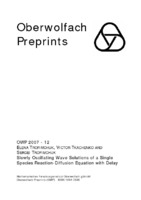| dc.contributor.author | Trofimchuk, Elena | |
| dc.contributor.author | Tkachenko, Victor | |
| dc.contributor.author | Trofimchuk, Sergei I. | |
| dc.date.accessioned | 2007-03-20T12:00:08Z | |
| dc.date.accessioned | 2016-10-05T14:14:22Z | |
| dc.date.available | 2007-03-20T12:00:08Z | |
| dc.date.available | 2016-10-05T14:14:22Z | |
| dc.date.issued | 2007-03-28 | |
| dc.identifier.uri | http://publications.mfo.de/handle/mfo/1207 | |
| dc.description | Research in Pairs 2007 | en_US |
| dc.description.abstract | We study positive bounded wave solutions $u(t, x) = \phi(\nu \cdot x+ct)$, $\phi(-\infty)=0$, of equation $u_t(t, x)=\delta u(t,x)−u(t,x) +g(u(t−h,x))$, $x \in \mathbb{R}^m$(*). It is supposed that Eq. (∗) has exactly two non-negative equilibria: $u_1 \equiv 0$ and $u_2 \equiv \kappa>9$. The birth function $g \in C(\mathbb{R}_+, \mathbb{R}_+)$ satisfies a few mild conditions: it is unimodal and differentiable at $0,\kappa$. Some results also require the positive feedback of $g:[g(\text{max} g),\text{max} g] \to \mathbb{R}_+$ with respect to $\kappa$. If additionally $\phi(+\infty) =\kappa$, the above wave solution $u(t,x)$ is called a travelling front. We prove that every wave $\phi(\nu \cdot x+ct)$ is eventually monotone or slowly oscillating about $\kappa$. Furthermore, we indicate $c^∗ \in \mathbb{R}_+ \cup {+\infty}$ such that (∗) does not have any travelling front (neither monotone nor non-monotone) propagating at velocity $c > c^∗$. Our results are based on a detailed geometric description of the wave profile $\phi$. In particular, the monotonicity of its leading edge is established. We also discuss the uniqueness problem indicating a subclass $\mathcal{G}$ of ’asymmetric’ tent maps such that given $g \in \mathcal{G}$, there exists exactly one travelling front for each fixed admissible speed. | en_US |
| dc.language.iso | en | en_US |
| dc.publisher | Mathematisches Forschungsinstitut Oberwolfach | en_US |
| dc.relation.ispartofseries | Oberwolfach Preprints;2007,12 | |
| dc.title | Slowly oscillating wave solutions of a single species reaction-diffusion equation with delay | en_US |
| dc.type | Preprint | en_US |
| dc.rights.license | Dieses Dokument darf im Rahmen von § 53 UrhG zum eigenen Gebrauch kostenfrei heruntergeladen, gelesen, gespeichert und ausgedruckt, aber nicht im Internet bereitgestellt oder an Außenstehende weitergegeben werden. | de |
| dc.rights.license | This document may be downloaded, read, stored and printed for your own use within the limits of § 53 UrhG but it may not be distributed via the internet or passed on to external parties. | en |
| dc.identifier.doi | 10.14760/OWP-2007-12 | |
| local.scientificprogram | Research in Pairs 2007 | |
| local.series.id | OWP-2007-12 | |
| local.subject.msc | 34 | |
| local.subject.msc | 35 | |
| local.subject.msc | 92 | |
| dc.identifier.urn | urn:nbn:de:101:1-20080627180 | |
| dc.identifier.ppn | 1646163427 | |

